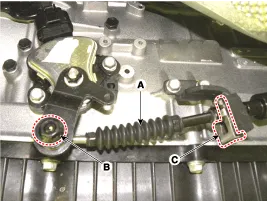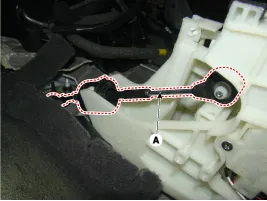Hyundai Genesis (DH): Automatic Transmission Control System / Shift Cable Repair procedures
Hyundai Genesis (DH) 2013-2016 Service Manual / Automatic Transmission System (SBC) / Automatic Transmission Control System / Shift Cable Repair procedures
| Removal |
| 1. |
Remove the nut (B) and clip (C). |
| 2. |
Remove the shift cable (A) assembly from the transmission.
|
| 3. |
Remove the floor console.
(Refer to Body-"Floor Console") |
| 4. |
Disconnect the shift cable (A) from the shift lever.
|
| 5. |
Remove the shift cable assembly (B) by removing the nuts (A).
|
| 6. |
Pull the rubber plug from the floor and pull out the shift cable assembly.
|
| Installation |
| 1. |
To install, reverse the removal procedure. |
| Adjustment |
| How to Adjust Shift Cable |
| 1. |
Insert the shift cable to the bracket and hold it with a new clip. |
| 2. |
Align the manual lever hole to the hole on the transmission case and hold the position with a bar. |
| 3. |
Eliminate shift cable free play of the shift cable. |
| 4. |
Firmly hold the special bolt with a wrench and tighten the nut(A) to the specified torque.
|
| 5. |
Take off the bar holding the manual lever. |
| 6. |
Shifting each position, check if the shift lever moves smoothly. |
Components 1. Shift lever knob2. Shift lever boots3. Shift lever assembly4. Shift cable
Other information:
Hyundai Genesis (DH) 2013-2016 Service Manual: Components and Components Location
C
Hyundai Genesis (DH) 2013-2016 Service Manual: Heater Unit Components and Components Location
Component Location Components (1) 1. Shower duct (Left)2. Mode actuator (LH)3. Temperature control actuator (LH)4. Temperature door lever (Left)5. Mode actuator (A)6. Console temperature actuator (A)7. Console mode actuator ON/OFF8. Heater case (Left)9.
Categories
- Manuals Home
- Hyundai Genesis Owners Manual
- Hyundai Genesis Service Manual
- Body Electrical System
- Emission Control System
- Engine Coolant Temperature Sensor (ECTS) Repair procedures
- New on site
- Most important about car
Copyright В© 2025 www.hgenesisdh.com - 0.0225




